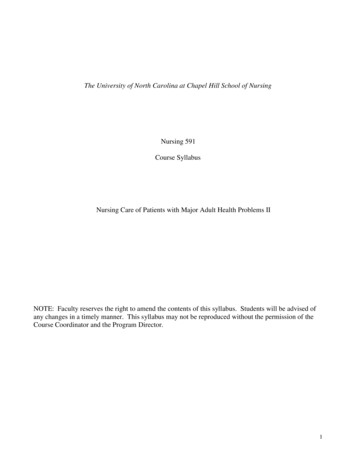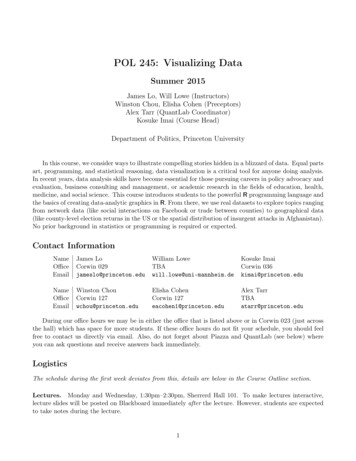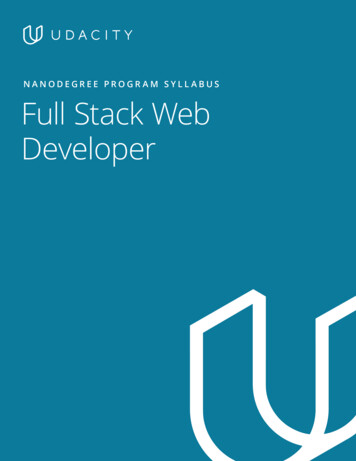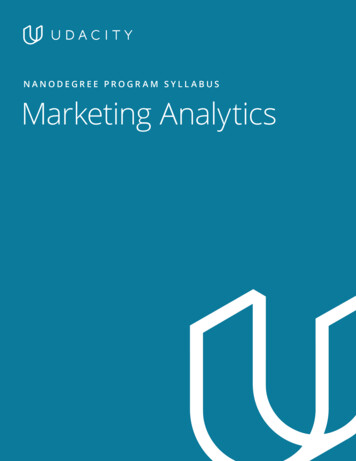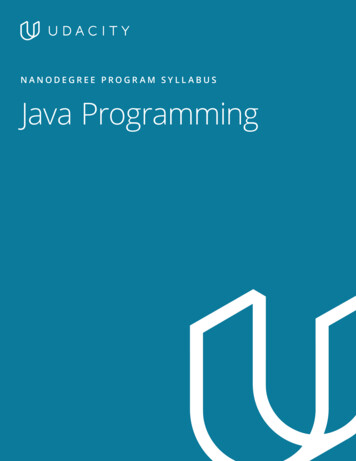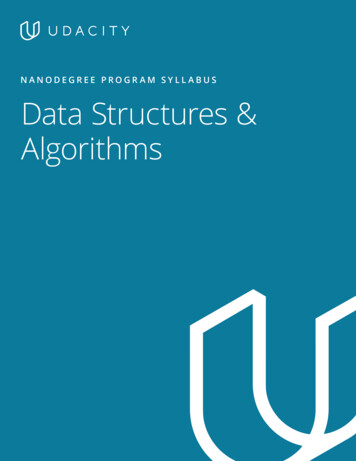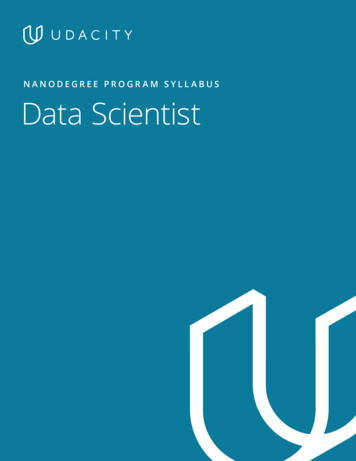
Transcription
NANODEGREE PROGR AM SYLL ABUSData ScientistNeed Help? Speak with an Advisor: www.udacity.com/advisor
OverviewThe Data Scientist Nanodegree program is an advanced program designed to prepare you for data scientistjobs. As such, you should have a high comfort level with a variety of topics before starting the program. Inorder to successfully complete this program, we strongly recommend that the following prerequisites arefulfilled. If you do not have the necessary prerequisites, Udacity has courses and programs that prepare youfor this Nanodegree program.Programming: Python Programming: Writing functions, logic, control flow, and building basic applications, as well ascommon data analysis libraries like NumPy and pandas SQL programming: Querying databases using joins, aggregations, and subqueries Comfortable with using the Terminal, version control in Git, and using GitHubProbability and Statistics: Descriptive Statistics: Calculating measures of center and spread, estimation distributions Inferential Statistics: Sampling distributions, hypothesis testing Probability: Probability theory, conditional probabilityMathematics: Calculus: Maximizing and minimizing algebraic equations Linear Algebra: Matrix manipulation and multiplicationData wrangling: Accessing database, CSV, and JSON data Data cleaning and transformations using pandas and SklearnData visualization with matplotlib: Exploratory data analysis and visualization Explanatory data visualizations and dashboardsMachine Learning: Feature Engineering Supervised Learning: Regression, classification, decision trees, random forest Unsupervised Learning: PCA, ClusteringThe following programs can prepare you to take this nanodegree program. There are also several freecourses that you can use to prepare. Programming for Data Science with Python. Data Analyst Nanodegree Program. Intro to Machine Learning Nanodegree ProgramEducational Objectives: The ultimate goal of the Data Scientist Nanodegree program is for you to learn theskills you need to perform well as a data scientist. As a graduate of this program, you will be able to: Use Python and SQL to access and analyze data from several different data sources.Need Help? Speak with an Advisor: www.udacity.com/advisorData Scientist 2
Overview Use principles of statistics and probability to design and execute A/B tests and recommendationengines to assist businesses in making data-automated decisions. Deploy a data science solution to a basic flask app. Manipulate and analyze distributed datasets using Apache Spark. Communicate results effectively to stakeholders.I N CO L L A B O R AT I O N W I T HEstimated Time:4 Months at10hrs/weekPrerequisites:Python, SQL &StatisticsFlexible Learning:Self-paced, soyou can learn onthe schedule thatworks best for youNeed Help?udacity.com/advisorDiscuss this programwith an enrollmentadvisor.Need Help? Speak with an Advisor: www.udacity.com/advisorData Scientist 3
Course 1: Solving Data Science ProblemsLearn the data science process, including how to build effective data visualizations, and how tocommunicate with various stakeholders.Course ProjectWrite a Data ScienceBlog PostIn this project, you will choose a dataset, identify three questions,and analyze the data to find answers to these questions. You willcreate a GitHub repository with your project, and write a blog postto communicate your findings to the appropriate audience. Thisproject will help you reinforce and extend your knowledge ofmachine learning, data visualization, and communicationLEARNING OUTCOMESLESSON ONELESSON TWOThe Data ScienceProcess Apply the CRISP-DM process to business applications Wrangle, explore, and analyze a dataset Apply machine learning for prediction Apply statistics for descriptive and inferentialunderstanding Draw conclusions that motivate others to act on yourresultsCommunicating withStakeholders Implement best practices in sharing your code and writtensummaries Learn what makes a great data science blog Learn how to create your ideas with the data sciencecommunityNeed Help? Speak with an Advisor: www.udacity.com/advisorData Scientist 4
Course 2: Software Engineering forData ScientistsDevelop software engineering skills that are essential for data scientists, such as creating unit tests andbuilding classes.LEARNING OUTCOMESLESSON ONELESSON TWOLESSON THREESoftware EngineeringPractices Write clean, modular, and well-documented code Refactor code for efficiency Create unit tests to test programs Write useful programs in multiple scripts Track actions and results of processes with logging Conduct and receive code reviewsObject OrientedProgramming Understand when to use object oriented programming Build and use classes Understand magic methods Write programs that include multiple classes, and followgood code structure Learn how large, modular Python packages, such as pandasand scikit-learn, use object oriented programming Portfolio Exercise: Build your own Python packageWeb Development Learn about the components of a web app Build a web application that uses Flask, Plotly, and theBootstrap framework Portfolio Exercise: Build a data dashboard using a datasetof your choice and deploy it to a web applicationNeed Help? Speak with an Advisor: www.udacity.com/advisorData Scientist 5
Course 3: Data Engineering for Data ScientistsLearn to work with data through the entire data science process, from running pipelines, transforming data,building models, and deploying solutions to the cloud.Course ProjectBuild Disaster ResponsePipelines with FigureEightFigure Eight (formerly Crowdflower) crowdsourced the tagging andtranslation of messages to apply artificial intelligence to disasterresponse relief. In this project, you’ll build a data pipeline to preparethe message data from major natural disasters around the world.You’ll build a machine learning pipeline to categorize emergency textmessages based on the need communicated by the sender.LEARNING OUTCOMESLESSON ONELESSON TWOLESSON THREEETL Pipelines Understand what ETL pipelines are Access and combine data from CSV, JSON, logs, APIs, anddatabases Standardize encodings and columns Normalize data and create dummy variables Handle outliers, missing values, and duplicated data Engineer new features by running calculations Build a SQLite database to store cleaned dataNatural LanguageProcessing Prepare text data for analysis with tokenization,lemmatization, and removing stop words Use scikit-learn to transform and vectorize text data Build features with bag of words and tf-idf Extract features with tools such as named entityrecognition and part of speech tagging Build an NLP model to perform sentiment analysisMachine LearningPipelines Understand the advantages of using machine learningpipelines to streamline the data preparation and modelingprocess Chain data transformations and an estimator with scikitlearn’s Pipeline Use feature unions to perform steps in parallel and createmore complex workflows Grid search over pipeline to optimize parameters for entireworkflow Complete a case study to build a full machine learningpipeline that prepares data and creates a model for adatasetNeed Help? Speak with an Advisor: www.udacity.com/advisorData Scientist 6
Course 4: Experiment Design andRecommendationsLearn to design experiments and analyze A/B test results. Explore approaches for buildingrecommendation systems.Course ProjectDesign aRecommendation Enginewith IBMIBM has an online data science community where members can posttutorials, notebooks, articles, and datasets. In this project, you willbuild a recommendation engine, based on user behavior and socialnetwork in IBM Watson Studio’s data platform, to surface contentmost likely to be relevant to a user.LEARNING OUTCOMESLESSON ONEExperiment Design Understand how to set up an experiment, and the ideasassociated with experiments vs. observational studies Defining control and test conditions Choosing control and testing groupsLESSON TWOStatistical Concernsof Experimentation Applications of statistics in the real world Establishing key metrics SMART experiments: Specific, Measurable, Actionable,Realistic, TimelyA/B Testing How it works and its limitations Sources of Bias: Novelty and Recency Effects Multiple Comparison Techniques (FDR, Bonferroni, Tukey) Portfolio Exercise: Using a technical screener from Starbucksto analyze the results of an experiment and write up yourfindingsLESSON THREENeed Help? Speak with an Advisor: www.udacity.com/advisorData Scientist 7
LESSON FOURLESSON FIVEIntroduction toRecommendationEngines Distinguish between common techniques for creatingrecommendation engines including knowledge based,content based, and collaborative filtering based methods. Implement each of these techniques in python. List business goals associated with recommendation engines,and be able to recognize which of these goals are most easilymet with existing recommendation techniques.MatrixFactorization forRecommendations Understand the pitfalls of traditional methods and pitfalls ofmeasuring the influence of recommendation engines undertraditional regression and classification techniques. Create recommendation engines using matrix factorizationand FunkSVD Interpret the results of matrix factorization to betterunderstand latent features of customer data Determine common pitfalls of recommendation engines likethe cold start problem and difficulties associated with usualtactics for assessing the effectiveness of recommendationengines using usual techniques, and potential solutions.Need Help? Speak with an Advisor: www.udacity.com/advisorData Scientist 8
Course 5: Data Science ProjectsLeverage what you’ve learned throughout the program to build your own open-ended Data Science project.This project will serve as a demonstration of your valuable abilities as a Data Scientist.Course ProjectData Science CapstoneProjectIn this capstone project, you will leverage what you’ve learnedthroughout the program to build a data science project of yourchoosing. You will define the problem you want to solve, identifyand explore the data, then perform your analyses and develop a setof conclusions. You will present the analysis and your conclusionsin a blog post and GitHub repository. This project will serve as ademonstration of your ability as a data scientist, and will be animportant component of your job-ready portfolio.LEARNING OUTCOMESElective 1:Dog BreedClassification Use convolutional neural networks to classify different dogsaccording to their breeds Deploy your model to allow others to upload images of theirdogs and send them back the corresponding breeds. Complete one of the most popular projects in Udacity history,and show the world how you can use your deep learning skillsto entertain an audience!LESSON TWOElective 2:Starbucks Use purchasing habits to arrive at discount measures toobtain and retain customers Identify groups of individuals that are most likely to beresponsive to rebates.LESSON THREEElective 3: ArvatoFinancial Services Work through a real-world dataset and challenge provided byArvato Financial Services, a Bertelsmann company Top performers have a chance at an interview with Arvato oranother Bertelsmann company!LESSON ONENeed Help? Speak with an Advisor: www.udacity.com/advisorData Scientist 9
LESSON FOURElective 4: Sparkfor Big Data Take a course on Apache Spark and complete a project using amassive, distributed dataset to predict customer churn Learn to deploy your Spark cluster on either AWS or IBMCloudLESSON FIVEElective 5: YourChoice Use your skills to tackle any other project of your choiceNeed Help? Speak with an Advisor: www.udacity.com/advisorData Scientist 10
Our Classroom ExperienceREAL-WORLD PROJECTSBuild your skills through industry-relevant projects. Getpersonalized feedback from our network of 900 projectreviewers. Our simple interface makes it easy to submityour projects as often as you need and receive unlimitedfeedback on your work.KNOWLEDGEFind answers to your questions with Knowledge, ourproprietary wiki. Search questions asked by other students,connect with technical mentors, and discover in real-timehow to solve the challenges that you encounter.WORKSPACESSee your code in action. Check the output and quality ofyour code by running them on workspaces that are a partof our classroom.QUIZZESCheck your understanding of concepts learned in theprogram by answering simple and auto-graded quizzes.Easily go back to the lessons to brush up on conceptsanytime you get an answer wrong.CUSTOM STUDY PLANSCreate a custom study plan to suit your personal needsand use this plan to keep track of your progress towardyour goal.PROGRESS TRACKERStay on track to complete your Nanodegree program withuseful milestone reminders.Need Help? Speak with an Advisor: www.udacity.com/advisorData Scientist 11
Learn with the BestJosh BernhardJuno LeeDATA S C I E N T I S TDATA S C I E N C E I N S T R U C TO RJosh has been sharing his passion fordata for nearly a decade at all levels ofuniversity, and as Lead Data ScienceInstructor at Galvanize. He’s used datascience for work ranging from cancerresearch to process automation.As a data scientist, Juno built arecommendation engine to personalizeonline shopping experiences, computervision and natural language processingmodels to analyze product data, and toolsto generate insight into user behavior.Luis SerranoAndrew PasterI N S T R U C TO RI N S T R U C TO RLuis was formerly a Machine LearningEngineer at Google. He holds a PhD inmathematics from the University ofMichigan, and a Postdoctoral Fellowship atthe University of Quebec at Montreal.Andrew has an engineering degree fromYale, and has used his data science skills tobuild a jewelry business from the groundup. He has additionally created coursesfor Udacity’s Self-Driving Car EngineerNanodegree program.Need Help? Speak with an Advisor: www.udacity.com/advisorData Scientist 12
Learn with the BestMike YiDavid DrummondDATA S C I E N T I S TVP OF ENGINEERINGMike is a Content Developer with amultidisciplinary academic background,including math, statistics, physics, andpsychology. Previously, he worked onUdacity’s Data Analyst Nanodegreeprogram as a support lead.David is VP of Engineering at Insightwhere he enjoys breaking down difficultconcepts and helping others learn dataengineering. David has a PhD in Physicsfrom UC Riverside.Judit LantosS E N I O R DATA E N G I N E E RCurrently, Judit is a Senior Data Engineerat Netflix. Formerly a Data Engineer atSplit, where she worked on the statisticalengine of their full-stack experimentationplatform, she has also been an instructorat Insight Data Science, helping softwareengineers and academic coders transitionto DE roles.Need Help? Speak with an Advisor: www.udacity.com/advisorData Scientist 13
All Our Nanodegree Programs Include:EXPERIENCED PROJECT REVIEWERSREVIEWER SERVICES Personalized feedback & line by line code reviews 1600 Reviewers with a 4.85/5 average rating 3 hour average project review turnaround time Unlimited submissions and feedback loops Practical tips and industry best practices Additional suggested resources to improveTECHNICAL MENTOR SUPPORTMENTORSHIP SERVICES Questions answered quickly by our team oftechnical mentors 1000 Mentors with a 4.7/5 average rating Support for all your technical questionsPERSONAL CAREER SERVICESC AREER SUPPORT Resume support Github portfolio review LinkedIn profile optimizationNeed Help? Speak with an Advisor: www.udacity.com/advisorData Scientist 14
Frequently Asked QuestionsPROGR AM OVERVIE WWHY SHOULD I ENROLL?The data science field is expected to continue growing rapidly over the nextseveral years, and there’s huge demand for data scientists across industries.Data scientist is consistently rated as a top career.Udacity has collaborated with industry leaders to offer a world-class learningexperience so you can advance your data science career. You’ll get handson experience running data pipelines, designing experiments, buildingrecommendation systems, and more. You’ll have personalized support asyou master in-demand skills that qualify you for high-value jobs in the datascience field.By the end of the program, you’ll have an impressive portfolio of real-worldprojects, and valuable hands-on experience. You’ll also receive career supportvia profile and portfolios reviews to help make sure you’re ready to establish asuccessful data science career, and land a job you love.WHAT JOBS WILL THIS PROGRAM PREPARE ME FOR?Obtaining the skills required to be a Data Scientist will make you extremelyvaluable across many industries, and in many roles. Data Scientists work asAnalysts, Statisticians, Engineers, and more. Some become Data and AnalyticsManagers, while others specialize as Database Administrators. As a graduateof this program, you’ll be prepared to seek out roles that run the gamut fromgeneralist to specialist, and all points in between.HOW DO I KNOW IF THIS PROGRAM IS RIGHT FOR ME?This program offers an ideal path for experienced programmers anddata analysts to advance their data science careers. If you’re interested indeepening your expertise in the fields of analytics, machine learning, dataengineering, and/or data science, this is a great way to get hands on practicewith a variety of techniques and learn to build end to end data sciencesolutions.WHAT IS THE DIFFERENCE BETWEEN THE DATA ANALYST, MACHINELEARNING ENGINEER, AND THE DATA SCIENTIST NANODEGREEPROGRAMS?The Data Analyst program is designed for people with some data analysisexperience and little-to-no programming experience. Students will learn toanalyze data using Python and SQL, to wrangle and clean messy data, touse applied statistics to test hypotheses, and to create data visualizations.Graduates of this program will be prepared for data analyst positions.The Data Scientist Nanodegree program is designed for students with strongprogramming and data analysis skills, as it is the next step for graduates ofNeed Help? Speak with an Advisor: www.udacity.com/advisorData Scientist 15
FAQs Continuedthe Data Analyst Nanodegree program. Students will learn to build machinelearning models, run data pipelines, design experiments and recommendationengines, communicate effectively, and to deploy data applications. Graduatesof this program will be prepared for data scientist positions.The Machine Learning Engineer Nanodegree program prepares students formachine learning engineering careers. As both data scientist and machinelearning jobs require machine learning knowledge, each of these twoprograms begins with a focus on machine learning. The curriculum divergesin later sections as you begin to focus on more job-specific tools, skills, andtechniques.ENROLLMENT AND ADMISSIONDO I NEED TO APPLY? WHAT ARE THE ADMISSION CRITERIA?No. This Nanodegree program accepts all applicants regardless of experienceand specific background.WHAT ARE THE PREREQUISITES FOR ENROLLMENT?The Data Scientist Nanodegree program is designed for students withprogramming and data analysis experience. Students should have a highcomfort level with a variety of topics before starting the program. In orderto successfully complete this program, you should meet the followingprerequisites: Python programming, including common data analysis libraries (NumPy,pandas, Matplotlib). SQL programming Statistics (Descriptive and Inferential) Calculus Linear Algebra Experience wrangling and visualizing dataIF I DO NOT MEET THE REQUIREMENTS TO ENROLL, WHAT SHOULD I DO?Udacity’s Data Analyst Nanodegree program is great preparation for the DataScientist Nanodegree program. You’ll learn programming with Python andSQL, applied statistics, data wrangling, and data visualization.You can also prepare by taking a number of Udacity’s free courses, such as: Introduction to Data Science Introduction to Python SQL for Data Analysis Statistics Linear AlgebraNeed Help? Speak with an Advisor: www.udacity.com/advisorData Scientist 16
FAQs Continued Data Visualization with TableauTUITION AND TERM OF PROGR AMHOW IS THIS NANODEGREE PROGRAM STRUCTURED?The Data Scientist Nanodegree program is comprised of content andcurriculum to support four (4) projects. We estimate that students cancomplete the program in four (4) months working 10 hours per week.Each project will be reviewed by the Udacity reviewer network. Feedback willbe provided and if you do not pass the project, you will be asked to resubmitthe project until it passes.HOW LONG IS THIS NANODEGREE PROGRAM?Access to this Nanodegree program runs for the length of time specified inthe payment card above. If you do not graduate within that time period, youwill continue learning with month to month payments. See the Terms of Useand FAQs for other policies regarding the terms of access to our Nanodegreeprograms.SOF T WARE AND HARDWAREWHAT SOFTWARE AND VERSIONS WILL I NEED IN THIS PROGRAM?To successfully complete this Nanodegree program, you’ll need to be able todownload and run Python 3.7.Need Help? Speak with an Advisor: www.udacity.com/advisorData Scientist 17
The Data Scientist Nanodegree program is an advanced program designed to prepare you for data scientist . for Big Data Take a course on Apache Spark and complete a project using a massive, distributed dataset to predict customer churn



